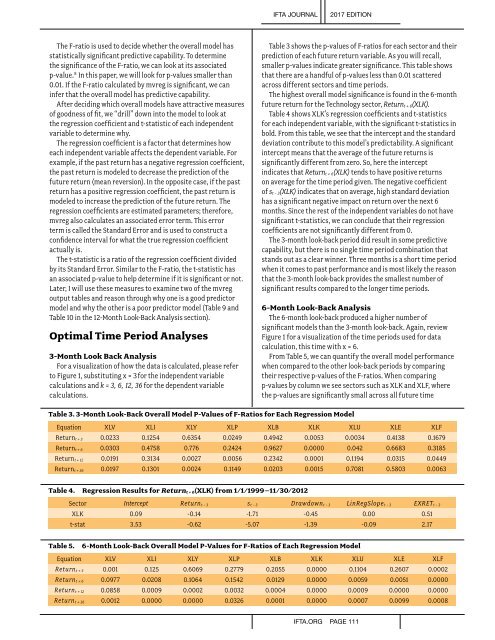Create successful ePaper yourself
Turn your PDF publications into a flip-book with our unique Google optimized e-Paper software.
IFTA JOURNAL<br />
2017 EDITION<br />
The F-ratio is used to decide whether the overall model has<br />
statistically significant predictive capability. To determine<br />
the significance of the F-ratio, we can look at its associated<br />
p-value. 8 In this paper, we will look for p-values smaller than<br />
0.01. If the F-ratio calculated by mvreg is significant, we can<br />
infer that the overall model has predictive capability.<br />
After deciding which overall models have attractive measures<br />
of goodness of fit, we “drill” down into the model to look at<br />
the regression coefficient and t-statistic of each independent<br />
variable to determine why.<br />
The regression coefficient is a factor that determines how<br />
each independent variable affects the dependent variable. For<br />
example, if the past return has a negative regression coefficient,<br />
the past return is modeled to decrease the prediction of the<br />
future return (mean reversion). In the opposite case, if the past<br />
return has a positive regression coefficient, the past return is<br />
modeled to increase the prediction of the future return. The<br />
regression coefficients are estimated parameters; therefore,<br />
mvreg also calculates an associated error term. This error<br />
term is called the Standard Error and is used to construct a<br />
confidence interval for what the true regression coefficient<br />
actually is.<br />
The t-statistic is a ratio of the regression coefficient divided<br />
by its Standard Error. Similar to the F-ratio, the t-statistic has<br />
an associated p-value to help determine if it is significant or not.<br />
Later, I will use these measures to examine two of the mvreg<br />
output tables and reason through why one is a good predictor<br />
model and why the other is a poor predictor model (Table 9 and<br />
Table 10 in the 12-Month Look-Back Analysis section).<br />
Optimal Time Period Analyses<br />
3-Month Look Back Analysis<br />
For a visualization of how the data is calculated, please refer<br />
to Figure 1, substituting x = 3 for the independent variable<br />
calculations and k = 3, 6, 12, 36 for the dependent variable<br />
calculations.<br />
Table 3 shows the p-values of F-ratios for each sector and their<br />
prediction of each future return variable. As you will recall,<br />
smaller p-values indicate greater significance. This table shows<br />
that there are a handful of p-values less than 0.01 scattered<br />
across different sectors and time periods.<br />
The highest overall model significance is found in the 6-month<br />
future return for the Technology sector, Return t + 6 (XLK).<br />
Table 4 shows XLK’s regression coefficients and t-statistics<br />
for each independent variable, with the significant t-statistics in<br />
bold. From this table, we see that the intercept and the standard<br />
deviation contribute to this model’s predictability. A significant<br />
intercept means that the average of the future returns is<br />
significantly different from zero. So, here the intercept<br />
indicates that Return t + 6 (XLK) tends to have positive returns<br />
on average for the time period given. The negative coefficient<br />
of s t − 3 (XLK) indicates that on average, high standard deviation<br />
has a significant negative impact on return over the next 6<br />
months. Since the rest of the independent variables do not have<br />
significant t-statistics, we can conclude that their regression<br />
coefficients are not significantly different from 0.<br />
The 3-month look-back period did result in some predictive<br />
capability, but there is no single time period combination that<br />
stands out as a clear winner. Three months is a short time period<br />
when it comes to past performance and is most likely the reason<br />
that the 3-month look-back provides the smallest number of<br />
significant results compared to the longer time periods.<br />
6-Month Look-Back Analysis<br />
The 6-month look-back produced a higher number of<br />
significant models than the 3-month look-back. Again, review<br />
Figure 1 for a visualization of the time periods used for data<br />
calculation, this time with x = 6.<br />
From Table 5, we can quantify the overall model performance<br />
when compared to the other look-back periods by comparing<br />
their respective p-values of the F-ratios. When comparing<br />
p-values by column we see sectors such as XLK and XLF, where<br />
the p-values are significantly small across all future time<br />
Table 3. 3-Month Look-Back Overall Model P-Values of F-Ratios for Each Regression Model<br />
Equation XLV XLI XLY XLP XLB XLK XLU XLE XLF<br />
Return t + 3 0.0233 0.1254 0.6354 0.0249 0.4942 0.0053 0.0034 0.4138 0.1679<br />
Return t + 6 0.0303 0.4758 0.776 0.2424 0.9627 0.0000 0.042 0.6683 0.3185<br />
Return t + 12 0.0191 0.3134 0.0027 0.0056 0.2342 0.0001 0.1194 0.0315 0.0449<br />
Return t + 36 0.0197 0.1301 0.0024 0.1149 0.0203 0.0015 0.7081 0.5803 0.0063<br />
Table 4. Regression Results for Return t + 6(XLK) from 1/1/1999–11/30/2012<br />
Sector Intercept Return t − 3 s t − 3 Drawdown t − 3 LinRegSlope t − 3 EXRET t − 3<br />
XLK 0.09 -0.14 -1.71 -0.45 0.00 0.51<br />
t-stat 3.53 -0.62 -5.07 -1.39 -0.09 2.17<br />
Table 5.<br />
6-Month Look-Back Overall Model P-Values for F-Ratios of Each Regression Model<br />
Equation XLV XLI XLY XLP XLB XLK XLU XLE XLF<br />
Return t + 3 0.001 0.125 0.6069 0.2779 0.2055 0.0000 0.1104 0.2607 0.0002<br />
Return t + 6 0.0977 0.0208 0.1064 0.1542 0.0129 0.0000 0.0059 0.0051 0.0000<br />
Return t + 12 0.0858 0.0009 0.0002 0.0032 0.0004 0.0000 0.0009 0.0000 0.0000<br />
Return t + 36 0.0012 0.0000 0.0000 0.0326 0.0001 0.0000 0.0007 0.0099 0.0008<br />
IFTA.ORG PAGE 111


